
A trolley boat (a descriptive neologism not used contemporaneously) is an electrically driven boat on canals and particularly in canal tunnels. It takes its energy like a tram or trolleybus from one or two overhead wires respectively. [1]

A trolley boat (a descriptive neologism not used contemporaneously) is an electrically driven boat on canals and particularly in canal tunnels. It takes its energy like a tram or trolleybus from one or two overhead wires respectively. [1]

Frank W. Hawley converted a conventional steam-driven canal boat into a trolley boat and demonstrated its benefits and limitations 1893 on the Erie Canal. It had two electric motors with 19 kW (25 hp) each, which drove the propellers. [1]
On a 21⁄2 miles (4 km) long section of the Brussels–Charleroi Canal operated from 1899 a propeller driven trolley boat as a tug. Another installation was built in 1933 on a section of the Marne–Rhine Canal and is still in use. A 33⁄4 miles (6 km) long overhead cable was installed at the 2 miles (3,3 km) long canal tunnel of the Canal de Bourgogne in the French Canton de Pouilly-en-Auxois. [1]
In 2012 Diversified Marine in Portland, Oregon built the new Buena Vista Ferry , which obtains its energy through an overhead cable, to connect Marion County and Polk County over the 220 meter wide Willamette River in Oregon. [2] The Straussee Ferry is the last remaining trolley ferry in Germany, since the ferryboat of Haßmersheim was decommissioned in September 2014. It has a single wire overhead power supply.

Transport in Belgium is facilitated with well-developed road, air, rail and water networks. The rail network has 2,950 km (1,830 mi) of electrified tracks. There are 118,414 km (73,579 mi) of roads, among which there are 1,747 km (1,086 mi) of motorways, 13,892 km (8,632 mi) of main roads and 102,775 km (63,861 mi) of other paved roads. There is also a well-developed urban rail network in Brussels, Antwerp, Ghent and Charleroi. The ports of Antwerp and Bruges-Zeebrugge are two of the biggest seaports in Europe. Brussels Airport is Belgium's biggest airport.

While a significant majority of water vessels are powered by diesel engines, with sail power and gasoline engines also popular, boats powered by electricity have been used for over 120 years. Electric boats were very popular from the 1880s until the 1920s, when the internal combustion engine became dominant. Since the energy crises of the 1970s, interest in this quiet and potentially renewable marine energy source has been increasing steadily, especially as more efficient solar cells have become available, for the first time making possible motorboats with an infinite range like sailboats. The first practical solar boat was probably constructed in 1975 in England. The first electric sailboat to complete a round-the-world tour, including a transit of the Panama Canal, using only green technologies is EcoSailingProject.

A trolleybus is an electric bus that draws power from dual overhead wires using spring-loaded trolley poles. Two wires, and two trolley poles, are required to complete the electrical circuit. This differs from a tram or streetcar, which normally uses the track as the return path, needing only one wire and one pole. They are also distinct from other kinds of electric buses, which usually rely on batteries. Power is most commonly supplied as 600-volt direct current, but there are exceptions.
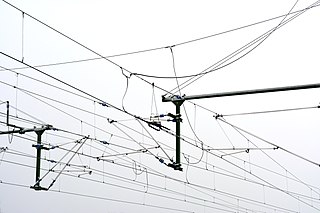
An overhead line or overhead wire is an electrical cable that is used to transmit electrical energy to electric locomotives, trolleybuses or trams. It is known variously as:
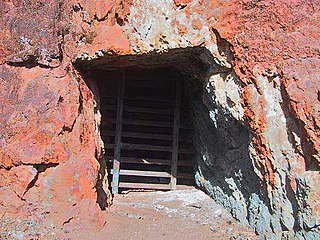
An adit is an entrance to an underground mine which is horizontal or nearly horizontal, by which the mine can be entered, drained of water, ventilated, and minerals extracted at the lowest convenient level. Adits are also used to explore for mineral veins.

A railway electrification system supplies electric power to railway trains and trams without an on-board prime mover or local fuel supply. Electric railways use either electric locomotives, electric multiple units or both. Electricity is typically generated in large and relatively efficient generating stations, transmitted to the railway network and distributed to the trains. Some electric railways have their own dedicated generating stations and transmission lines, but most purchase power from an electric utility. The railway usually provides its own distribution lines, switches, and transformers.

A cable ferry is a ferry that is guided across a river or large body of water by cables connected to both shores. Early cable ferries often used either rope or steel chains, with the latter resulting in the alternative name of chain ferry. Both of these were largely replaced by wire cable by the late 19th century.

The Canal de Bourgogne is a canal in the Burgundy historical region in east-central France. It connects the Yonne at Migennes with the Saône at Saint-Jean-de-Losne. Construction began in 1775 and was completed in 1832. The canal completes the link between the English Channel and the Mediterranean Sea, via the rivers Seine and the Yonne to the Saône and Rhône.
Various terms are used for passenger railway lines and equipment; the usage of these terms differs substantially between areas:

The Wheatland Ferry is a cable ferry that connects Marion County and Yamhill County across the Willamette River in the U.S. state of Oregon. The ferry travels approximately 580 feet across the river, depending on the height of the river, and is powered by two electric motors connected to an on-board diesel generator. The ferry is supported by two steel cables, one under water on the downriver side, and one overhead on the upriver side. The ferry also uses the overhead cable for steering.

The Sacramento Northern Railway was a 183-mile (295 km) electric interurban railway that connected Chico in northern California with Oakland via the California capital, Sacramento. In its operation it ran directly on the streets of Oakland, Sacramento, Yuba City, Chico, and Woodland and ran interurban passenger service until 1941 and freight service into the 1960s.

The Buena Vista Ferry connects Marion County and Polk County across the Willamette River in the U.S. state of Oregon. It is located a few miles south of Independence, near the community of Buena Vista. The river is approximately 720 feet wide at the crossing. The cable ferry has a capacity of six vehicles.
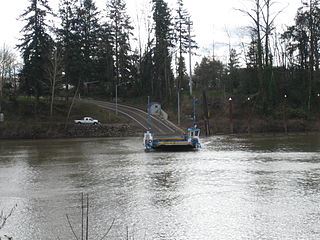
The Canby Ferry is a cable ferry in the U.S. state of Oregon that connects Canby, and Wilsonville/Stafford in Clackamas County across the Willamette River. The service has been in operation since 1914, except from 1946 to 1953. The specific vessel used has been replaced and updated several times, most recently in 1997. It is one of three remaining ferries on the Willamette River.
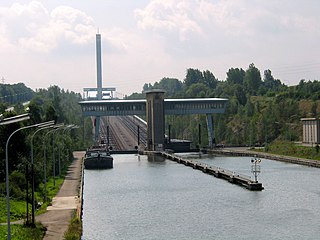
The Ronquières Inclined Plane is a Belgian canal inclined plane on the Brussels-Charleroi Canal in the province of Hainaut in Wallonia that opened in April 1968 after six years of construction. It is in the municipality of Braine-le-Comte and takes its name from the nearby village of Ronquières.

The Brussels–Charleroi Canal, also known as the Charleroi Canal amongst other similar names, is an important canal in Belgium. The canal is quite large, with a Class IV Freycinet gauge, and its Walloon portion is 47.9 kilometres (29.8 mi) long. It runs from Charleroi, Wallonia in the south to Brussels in the north. It is part of a north-south axis of water transport in Belgium, whereby the north of France including Lille and Dunkirk and important waterways in the south of Belgium including the Sambre valley and sillon industriel are linked to the port of Antwerp in the north, via the Brussels–Scheldt Maritime Canal which meets the Brussels–Charleroi Canal at the Sainctelette area.

Many steamboats operated on the Columbia River and its tributaries, in the Pacific Northwest region of North America, from about 1850 to 1981. Major tributaries of the Columbia that formed steamboat routes included the Willamette and Snake rivers. Navigation was impractical between the Snake River and the Canada–US border, due to several rapids, but steamboats also operated along the Wenatchee Reach of the Columbia, in northern Washington, and on the Arrow Lakes of southern British Columbia.
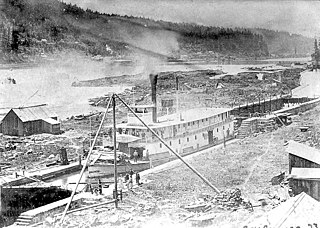
The Willamette River flows northwards down the Willamette Valley until it meets the Columbia River at a point 101 miles from the Pacific Ocean, in the U.S. state of Oregon.

The Oregon Electric Railway Museum is the largest streetcar/trolley museum in the Pacific Northwest of the United States. It is owned and operated by the Oregon Electric Railway Historical Society and is located in Brooks, Oregon, on the grounds of Powerland Heritage Park.

Public transport is a system of transport for passengers by group travel systems available for use by the general public unlike private transport, typically managed on a schedule, operated on established routes, and that charge a posted fee for each trip. There is no rigid definition; the Encyclopædia Britannica specifies that public transportation is within urban areas, and air travel is often not thought of when discussing public transport—dictionaries use wording like "buses, trains, etc." Examples of public transport include city buses, trolleybuses, trams and passenger trains, rapid transit and ferries. Public transport between cities is dominated by airlines, coaches, and intercity rail. High-speed rail networks are being developed in many parts of the world.

The Seattle trolleybus system forms part of the public transportation network in the city of Seattle, Washington, operated by King County Metro. Originally opened on April 28, 1940, the network consists of 15 routes, with 174 trolleybuses operating on 68 miles (109 km) of two-way parallel overhead lines. As of the first quarter of 2022, the system carries riders on an average of 34,200 trips per weekday, comprising about 18 percent of King County Metro’s total daily ridership. At present in Seattle, a very common alternative term for trolleybus is trolley.